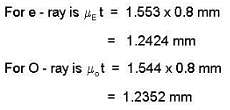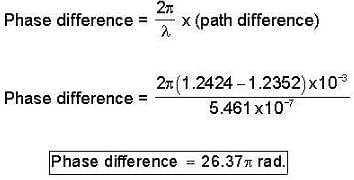Physics Exam > Physics Questions > A quartz plate 0.8 mm thick is illuminated at...
Start Learning for Free
A quartz plate 0.8 mm thick is illuminated at normal incidence by green light of wavelength  The optic axis is parallel to the surface, Then calculate the optical path of O-ray and e-ray travelling through the plate and the phase difference between these two. (Given that
The optic axis is parallel to the surface, Then calculate the optical path of O-ray and e-ray travelling through the plate and the phase difference between these two. (Given that  )
)
 The optic axis is parallel to the surface, Then calculate the optical path of O-ray and e-ray travelling through the plate and the phase difference between these two. (Given that
The optic axis is parallel to the surface, Then calculate the optical path of O-ray and e-ray travelling through the plate and the phase difference between these two. (Given that  )
)- a)Optical path of O-ray is 1.2352 nm
- b)Optical path of e-ray is 1.2424 nm
- c)Phase difference is 26.37π radian.
- d)Phase difference is 37π radian.
Correct answer is option 'A,B,C'. Can you explain this answer?
| FREE This question is part of | Download PDF Attempt this Test |
Verified Answer
A quartz plate 0.8 mm thick is illuminated at normal incidence by gree...
Optical paths.




Most Upvoted Answer
A quartz plate 0.8 mm thick is illuminated at normal incidence by gree...
Optical paths.





|
Explore Courses for Physics exam
|

|
A quartz plate 0.8 mm thick is illuminated at normal incidence by green light of wavelengthThe optic axis is parallel to the surface, Then calculate the optical path of O-ray and e-ray travelling through the plate and the phase difference between these two. (Given that)a)Optical path of O-ray is 1.2352 nmb)Optical path of e-ray is 1.2424 nmc)Phase difference is 26.37π radian.d)Phase difference is 37π radian.Correct answer is option 'A,B,C'. Can you explain this answer?
Question Description
A quartz plate 0.8 mm thick is illuminated at normal incidence by green light of wavelengthThe optic axis is parallel to the surface, Then calculate the optical path of O-ray and e-ray travelling through the plate and the phase difference between these two. (Given that)a)Optical path of O-ray is 1.2352 nmb)Optical path of e-ray is 1.2424 nmc)Phase difference is 26.37π radian.d)Phase difference is 37π radian.Correct answer is option 'A,B,C'. Can you explain this answer? for Physics 2024 is part of Physics preparation. The Question and answers have been prepared according to the Physics exam syllabus. Information about A quartz plate 0.8 mm thick is illuminated at normal incidence by green light of wavelengthThe optic axis is parallel to the surface, Then calculate the optical path of O-ray and e-ray travelling through the plate and the phase difference between these two. (Given that)a)Optical path of O-ray is 1.2352 nmb)Optical path of e-ray is 1.2424 nmc)Phase difference is 26.37π radian.d)Phase difference is 37π radian.Correct answer is option 'A,B,C'. Can you explain this answer? covers all topics & solutions for Physics 2024 Exam. Find important definitions, questions, meanings, examples, exercises and tests below for A quartz plate 0.8 mm thick is illuminated at normal incidence by green light of wavelengthThe optic axis is parallel to the surface, Then calculate the optical path of O-ray and e-ray travelling through the plate and the phase difference between these two. (Given that)a)Optical path of O-ray is 1.2352 nmb)Optical path of e-ray is 1.2424 nmc)Phase difference is 26.37π radian.d)Phase difference is 37π radian.Correct answer is option 'A,B,C'. Can you explain this answer?.
A quartz plate 0.8 mm thick is illuminated at normal incidence by green light of wavelengthThe optic axis is parallel to the surface, Then calculate the optical path of O-ray and e-ray travelling through the plate and the phase difference between these two. (Given that)a)Optical path of O-ray is 1.2352 nmb)Optical path of e-ray is 1.2424 nmc)Phase difference is 26.37π radian.d)Phase difference is 37π radian.Correct answer is option 'A,B,C'. Can you explain this answer? for Physics 2024 is part of Physics preparation. The Question and answers have been prepared according to the Physics exam syllabus. Information about A quartz plate 0.8 mm thick is illuminated at normal incidence by green light of wavelengthThe optic axis is parallel to the surface, Then calculate the optical path of O-ray and e-ray travelling through the plate and the phase difference between these two. (Given that)a)Optical path of O-ray is 1.2352 nmb)Optical path of e-ray is 1.2424 nmc)Phase difference is 26.37π radian.d)Phase difference is 37π radian.Correct answer is option 'A,B,C'. Can you explain this answer? covers all topics & solutions for Physics 2024 Exam. Find important definitions, questions, meanings, examples, exercises and tests below for A quartz plate 0.8 mm thick is illuminated at normal incidence by green light of wavelengthThe optic axis is parallel to the surface, Then calculate the optical path of O-ray and e-ray travelling through the plate and the phase difference between these two. (Given that)a)Optical path of O-ray is 1.2352 nmb)Optical path of e-ray is 1.2424 nmc)Phase difference is 26.37π radian.d)Phase difference is 37π radian.Correct answer is option 'A,B,C'. Can you explain this answer?.
Solutions for A quartz plate 0.8 mm thick is illuminated at normal incidence by green light of wavelengthThe optic axis is parallel to the surface, Then calculate the optical path of O-ray and e-ray travelling through the plate and the phase difference between these two. (Given that)a)Optical path of O-ray is 1.2352 nmb)Optical path of e-ray is 1.2424 nmc)Phase difference is 26.37π radian.d)Phase difference is 37π radian.Correct answer is option 'A,B,C'. Can you explain this answer? in English & in Hindi are available as part of our courses for Physics.
Download more important topics, notes, lectures and mock test series for Physics Exam by signing up for free.
Here you can find the meaning of A quartz plate 0.8 mm thick is illuminated at normal incidence by green light of wavelengthThe optic axis is parallel to the surface, Then calculate the optical path of O-ray and e-ray travelling through the plate and the phase difference between these two. (Given that)a)Optical path of O-ray is 1.2352 nmb)Optical path of e-ray is 1.2424 nmc)Phase difference is 26.37π radian.d)Phase difference is 37π radian.Correct answer is option 'A,B,C'. Can you explain this answer? defined & explained in the simplest way possible. Besides giving the explanation of
A quartz plate 0.8 mm thick is illuminated at normal incidence by green light of wavelengthThe optic axis is parallel to the surface, Then calculate the optical path of O-ray and e-ray travelling through the plate and the phase difference between these two. (Given that)a)Optical path of O-ray is 1.2352 nmb)Optical path of e-ray is 1.2424 nmc)Phase difference is 26.37π radian.d)Phase difference is 37π radian.Correct answer is option 'A,B,C'. Can you explain this answer?, a detailed solution for A quartz plate 0.8 mm thick is illuminated at normal incidence by green light of wavelengthThe optic axis is parallel to the surface, Then calculate the optical path of O-ray and e-ray travelling through the plate and the phase difference between these two. (Given that)a)Optical path of O-ray is 1.2352 nmb)Optical path of e-ray is 1.2424 nmc)Phase difference is 26.37π radian.d)Phase difference is 37π radian.Correct answer is option 'A,B,C'. Can you explain this answer? has been provided alongside types of A quartz plate 0.8 mm thick is illuminated at normal incidence by green light of wavelengthThe optic axis is parallel to the surface, Then calculate the optical path of O-ray and e-ray travelling through the plate and the phase difference between these two. (Given that)a)Optical path of O-ray is 1.2352 nmb)Optical path of e-ray is 1.2424 nmc)Phase difference is 26.37π radian.d)Phase difference is 37π radian.Correct answer is option 'A,B,C'. Can you explain this answer? theory, EduRev gives you an
ample number of questions to practice A quartz plate 0.8 mm thick is illuminated at normal incidence by green light of wavelengthThe optic axis is parallel to the surface, Then calculate the optical path of O-ray and e-ray travelling through the plate and the phase difference between these two. (Given that)a)Optical path of O-ray is 1.2352 nmb)Optical path of e-ray is 1.2424 nmc)Phase difference is 26.37π radian.d)Phase difference is 37π radian.Correct answer is option 'A,B,C'. Can you explain this answer? tests, examples and also practice Physics tests.

|
Explore Courses for Physics exam
|

|
Suggested Free Tests
Signup for Free!
Signup to see your scores go up within 7 days! Learn & Practice with 1000+ FREE Notes, Videos & Tests.
















